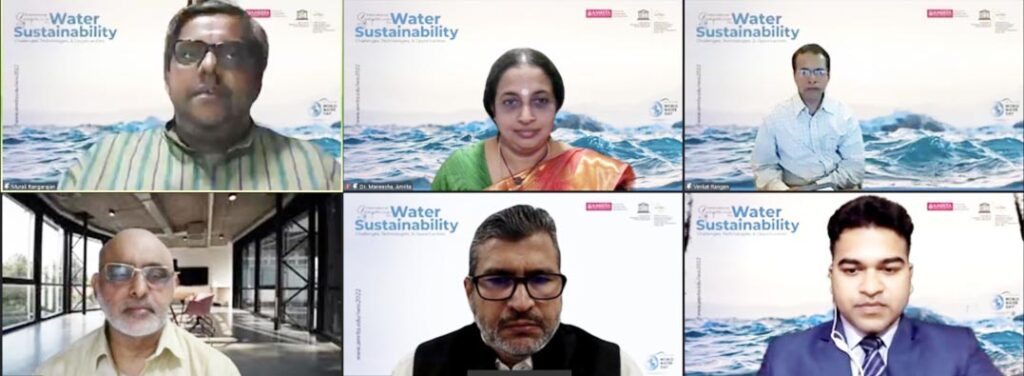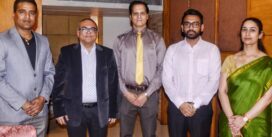- आकाश एजुकेशनल सर्विसेज लिमिटेड ने एस्पायरिंग इंजीनियर्स के लिए पेश किया “आकाश इनविक्टस”– अल्टीमेट JEE प्रिपरेशन प्रोग्राम
- Beyond Key Celebrated Women’s Day 2025 Across All its Offices
- Prasar Bharati and Eros Universe’s Eros Now Announce Strategic Collaboration to Enhance Digital Content Delivery
- Three Stars, a Cricket Match, and One Life-Changing Story: ‘TEST’ Premieres April 4
- Netflix Becomes the Exclusive Home for WWE in India Starting April 1
Amrita Vishwa Vidyapeetham Join Hands with Esri India for the launch of Mera Gaav, Hamara Jal Program

Mera Gaav, Hamar Jal program aims to ensure sustainable water access and availability to rural communities across India
New Delhi, 2022: To make water sustainability a reality for the communities across rural India, Amrita Vishwa Vidyapeetham and Esri India jointly launched a program “Mera Gaav, Hamara Jal” that translates to “My Village, Our Water”. This program aims to transform the attitudes of community members to view water as a community resource rather than as a personal resource.
The initiative aims to empower communities to map & monitor the resources, water quality, practices prevalent in the community, livelihood activities, drainage, weather variability, and climate impacts. This extensive crowd-sourced data will provide the opportunity to derive the water sustainability challenges in each of the communities. Along with this, it will equip the local administration, community organisations, and individuals to develop strategies for water conservation, optimise water usage, develop restoration of water resources, and build awareness of short and long-term impacts. The program which is in its infancy is currently rolled out in villages in Kerala. Within a year, the program is expected to reach 1000 communities in villages across India adopted under the Amrita Serve Program.

Speaking on the occasion, Mr. Agendra Kumar, Managing Director, Esri India expressed that Esri India is privileged to partner with Amrita Vishwa Vidyapeetham on this transformational initiative. “Mera Gaav, Hamara Jal” program will transform the way rural India looks at water sustainability. This would change the attitude of the communities as they start seeing water as ‘our resource’ rather than ‘my resource’. The program would encourage community participation as villagers themselves can collect and provide the data related to water availability, water consumption, etc.
The ArcGIS system will be used to create maps and dashboards for understanding trends and patterns, and thereby enabling different stakeholders like the local administration, NGOs, and citizens to take steps for more judicious use of the scarce resource and encourage water conservation. This initiative is an excellent way to collaboratively move towards the achievement of UN SDG 6, which aims to ensure availability and sustainable management of water and sanitation for all”.
Speaking at the launch of the program, Dr. P Venkat Rangan, Vice-Chancellor, Amrita Vishwa Vidyapeetham said that “It is with great delight that we announce the launch of Mera Gaav, Hamara Jal Program in collaboration with Esri India. The initiative that translates to My Village, Our Water aims to empower villagers to become champions in ensuring water sustainability at a community level. Water sustainability is a key national priority. Being home to 18% of the global population, India possesses only 4% of water resources across the world.
Through this partnership, we aim to empower villagers to map their water resources by including various aspects like sources, distribution, family wise consumption pattern and their demographic details via Amrita’s EMPOWER community app. This data will be used for mapping hotspots with respect to water sustainability which in turn will help to map the water quality. As we add one more page to Amrita’s array of activities in this regard, it gives me immense happiness to join hands with Esri India.”
Dr. Maneesha V Ramesh, UNESCO Chair on Experiential Learning for Sustainable Innovation and Development and Provost, Amrita Vishwa Vidyapeetham expressed her happiness over the launch of the program and provided a demonstration of ESRI’s ArcGIS dashboard which helps to capture information regarding the water resources mapped at the village level. The interactive dashboard provides information on water sources based on location and individual household level.
The program is planned to be rolled in a phased approach. As a part of the initial phase, community members will be trained to map and monitor water resources, assess water usage and quality so that they become more water conscious. To equip our future generations to become champions, the next phase of the project would involve training school children and teachers to make them water-wise. The future phases will see holistic empowerment of all the community members including children to achieve water sustainability. By including researchers and the general public, more data patterns will be incorporated for in-depth research. By joining hands with researchers, policies and recommendations are also planned to be rolled out to the government.
Thus, the initiative Mera Gaav, Hamara Jal aims to bring in a transformational change to perceive WATER as OURs rather than MINE. By empowering community members, water-wise communities will be sprouted to achieve community-scale implementation of UN SDG 6 targets.
The program was launched during the valedictory ceremony of the International Symposium on Water Sustainability – Challenges, Technologies and Opportunities (IWSS 2022) on 24th March. The 3-day symposium from 22 to 24 March was jointly organised by UNESCO Chair on Experiential Learning for Sustainable Innovation and Development and School for Sustainable Development, Amrita Vishwa Vidyapeetham on the occasion of World Water Day.
The valedictory ceremony also showcased various initiatives launched by the Amrita Live-in-Labs® program on the occasion of World Water Day. This includes the Water Day pledge by children in various communities across India to spread awareness and take initiatives directed towards water conservation. Painting competitions were also held in 25 communities to bring out the thought process of how children perceived water access and availability in their locality. The insights from the paintings will help to develop design requirements for the framework to build solutions aimed to ensure water sustainability for different communities. Prizes were awarded to 2 children who did exceptionally well in the competition.
Overall, the symposium had 26 eminent international keynote speakers from 15 universities, industry, government and non-government organisations. Some of the key institutions that participated are Kings College London, European Regional Centre for Ecohydrology PAS, Lawrence Berkeley National Laboratory, Delft University of Technology, Tel-Aviv University, Esri India, Wageningen University, the Netherlands to name a few. By focusing on six different themes, the symposium unveiled various pathways towards achieving water sustainability by adopting a community-centric approach towards conservation and revival of water resources.


